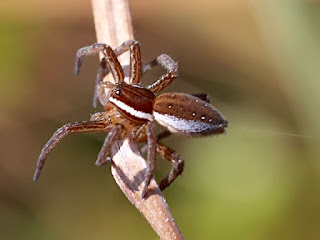Since there are a variety of different spiders and silk it stands to reason that there are a variety of different webs. The spider in the first pic is a yellow garden argiope. It is what is classified as an orb weaver spider. They create intricate webs which are used to catch prey. At the end of the day they will eat the old web, talk about recycling, and then spin a new one the next morning. Charlotte was a barn spider ( Aranea Cavatica) which is also a orb weaver. Some of the strands on the web are sticky so that they can catch prey while other strands are not sticky and allow the spider to move about freely. Another type of web is a funnel type (above). None of the strands on the funnel are sticky. Instead the funnel weaver sits in a hidden spot at the small side of the tunnel. When an insect flies into the funnel and becomes momentarily tangled the fast funnel weaver runs out and captures it before it can get away. Some of the funnel weavers in Australia are the deadliest spiders on earth.
Some spiders do not use their silk to help them catch prey. Fishing spiders, like the six spotted fishing spider above, often walk out on the water and kind of use it the way that a funnel weaver uses a web. When they feel a disturbance on the surface of the water, from an insect that fell in or a tadpole swimming by, they run across the water to catch their prey. Wolf spiders and jumping spiders are just a couple more examples of types of spiders that do not typically use webs to catch their prey. Even these types of spiders can still spin silk though. Many will use their silk to make an egg sack to protect their eggs. Others will spin a "dragline", as in the picture above. The dragline is a quick means of escape if the spider finds itself in danger. One minute the spider will be perched on a branch but as soon as it perceives danger it will drop rapidly from the perch using the dragline. Sometimes it will use it as a sort of chute sailing off into the wind on the dragline.






6 comments:
What a fascinating and educational post with pictures that show exactly what you are talking about. I certainly did not know the ones I see all the time eat their web and spin another the next day. Amazing!!! I have never seen one of the funnel type or the fishing type. Loved the post. genie
Educational but scares me half to death! *shiver*
Not especially a fan of spiders, but your narrative is so very interesting, and your pictures excellent.
Very interesting—although I prefer that those spiders stay far, far away!
Oh thanks for the information you put here. I have posted many kinds of webs just recently, as we have lots of them in our property, but i didn't see the funnel type you showed here. I am also not familiar with their habits so i learned here. But my webs photos are what i differentiated in my posts, thanks.
Great post on spiders Jeff..I hope as people know more that they will become less afraid as I did. Thank you for linking into Nature Notes this week...Michelle
Post a Comment